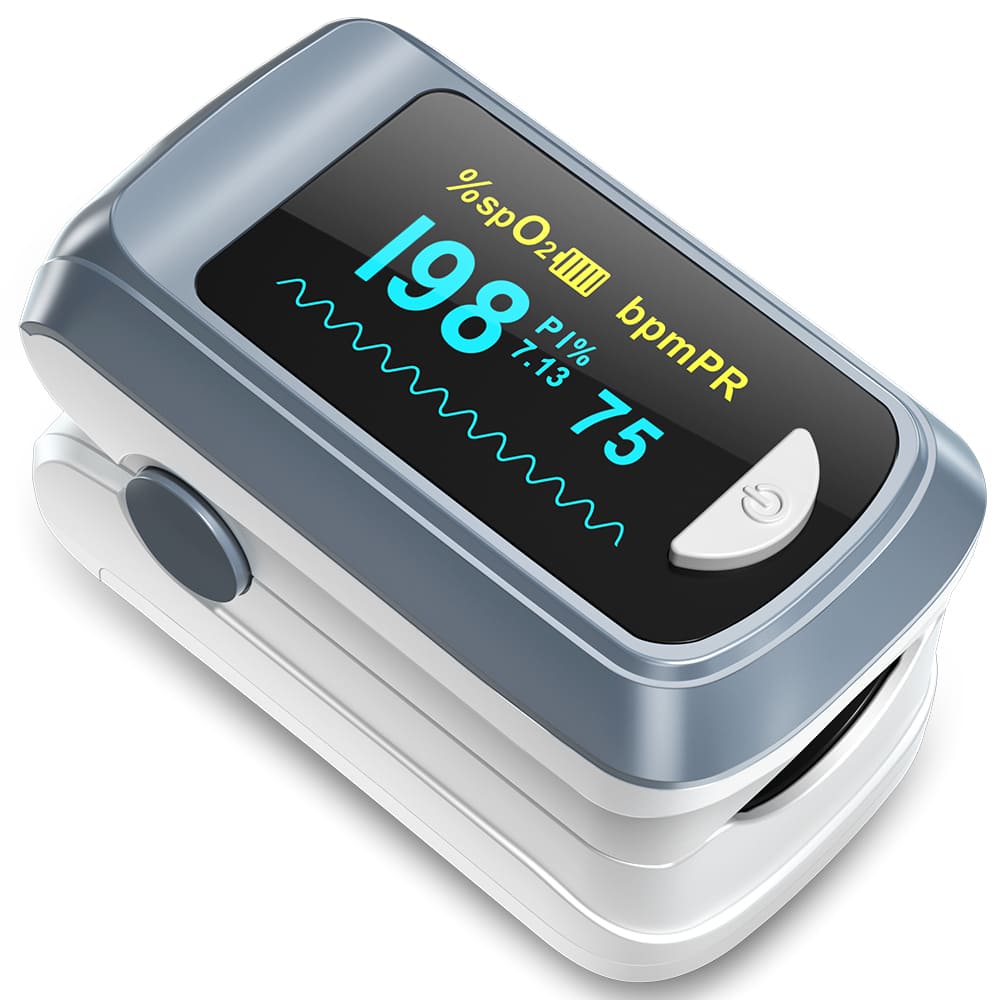
HOW DOES A PULSE OXIMETER WORK?
Share
The oximeter measures the amount of oxygen in the blood. This measurement is used to monitor the condition of patients with respiratory disorders or diseases of the respiratory system.
PHYSIOLOGY
The principle used for the operation of the pulse oximeter is based on the ability of blood to absorb red and infrared light, depending on its oxygen saturation. The calculation of the blood oxygen saturation rate noted SpO2 is based on the ratio of CHbO2 to CHb.
calculation 2
or
calculation spo2
CHbO2 being the blood concentration of oxyhaemoglobin and CHb is the total concentration of haemoglobin in the blood. Haemoglobin is a molecule in the blood that contains iron atoms and has a high affinity for oxygen. Red blood cells are made up of about 33% haemoglobin. This is what gives them the ability to transport oxygen from the lungs to the various tissues of the body.
When haemoglobin takes up oxygen in the lungs, it becomes oxyhaemoglobin and turns bright red and when this oxygen is released in the tissues, it becomes deoxyhaemoglobin. These two types of haemoglobin have different absorption rates for red and infrared light. Oxyhaemoglobin absorbs infrared light better and deoxyhaemoglobin absorbs red light better.
blood haemoglobin
OPERATION
The principle of absorbance allows the oxygen saturation level of a medium to be determined. Indeed, the quantity of light absorbed by a medium is proportional to its concentration of a given chemical species, according to Beer-lambert's law. The sensor, which is placed at the end of the finger, is equipped with a light transmitter and receiver.
The transmitter emits infrared light and red light via two LEDs. The red light has a wavelength of 660 nm, the infrared light has a wavelength of 950 nm. These two lights will pass through the skin and will be captured by a receiver, made up of a photodiode, which will quantify them.
how the oximeter works
A calculation on the quantity of absorbed light will make it possible to determine the blood saturation in oxygen. Blood saturation (SpO2) is expressed as a percentage and will give an estimate of the patient's condition. The normal value is between 90% and 100%. The oximeter will also measure the heart rate by measuring the variation of the different blood flows in the extremities.
In addition to the extremity sensor, the oximeter consists of a monitor and a cable if it is not compact. The cable is used to connect the sensor to the monitor, which has a computer that will analyse and translate the data received from the sensor. The sensor is shaped like a fingernail or finger clip and is placed on the fingers, ears and wings of the nose in adults or on the toes and foot in paediatric models.
PHYSIOLOGY
The principle used for the operation of the pulse oximeter is based on the ability of blood to absorb red and infrared light, depending on its oxygen saturation. The calculation of the blood oxygen saturation rate noted SpO2 is based on the ratio of CHbO2 to CHb.
calculation 2
or
calculation spo2
CHbO2 being the blood concentration of oxyhaemoglobin and CHb is the total concentration of haemoglobin in the blood. Haemoglobin is a molecule in the blood that contains iron atoms and has a high affinity for oxygen. Red blood cells are made up of about 33% haemoglobin. This is what gives them the ability to transport oxygen from the lungs to the various tissues of the body.
When haemoglobin takes up oxygen in the lungs, it becomes oxyhaemoglobin and turns bright red and when this oxygen is released in the tissues, it becomes deoxyhaemoglobin. These two types of haemoglobin have different absorption rates for red and infrared light. Oxyhaemoglobin absorbs infrared light better and deoxyhaemoglobin absorbs red light better.
blood haemoglobin
OPERATION
The principle of absorbance allows the oxygen saturation level of a medium to be determined. Indeed, the quantity of light absorbed by a medium is proportional to its concentration of a given chemical species, according to Beer-lambert's law. The sensor, which is placed at the end of the finger, is equipped with a light transmitter and receiver.
The transmitter emits infrared light and red light via two LEDs. The red light has a wavelength of 660 nm, the infrared light has a wavelength of 950 nm. These two lights will pass through the skin and will be captured by a receiver, made up of a photodiode, which will quantify them.
how the oximeter works
A calculation on the quantity of absorbed light will make it possible to determine the blood saturation in oxygen. Blood saturation (SpO2) is expressed as a percentage and will give an estimate of the patient's condition. The normal value is between 90% and 100%. The oximeter will also measure the heart rate by measuring the variation of the different blood flows in the extremities.
In addition to the extremity sensor, the oximeter consists of a monitor and a cable if it is not compact. The cable is used to connect the sensor to the monitor, which has a computer that will analyse and translate the data received from the sensor. The sensor is shaped like a fingernail or finger clip and is placed on the fingers, ears and wings of the nose in adults or on the toes and foot in paediatric models.
